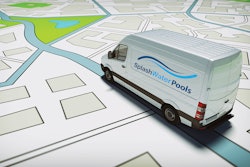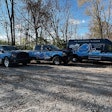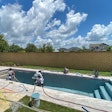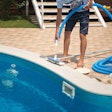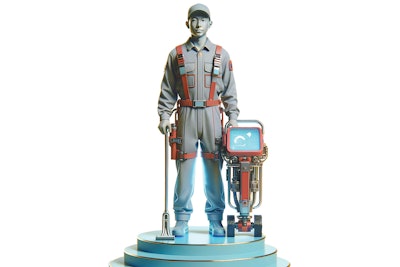
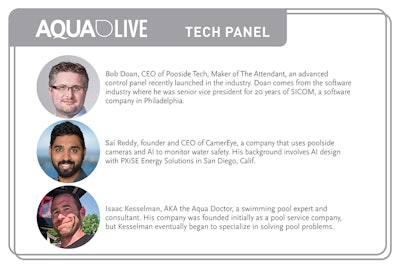
You get a notification Monday morning that the Smiths on Maple Street had a huge party last weekend, something is constricting their flow down to 9 GPM, and hot sunny weather is predicted all week. That place is incubating a baby swamp monster. You hadn't planned on servicing them till Friday, but you rearrange your schedule and get there today to slay that monster before it gets too big to kill.
Customer: Happy.
Chemical use, time and effort: Reduced.
Pool company: Running smoothly and profitably.
That is the future of pool care, according to a forward- thinking and tech-savvy panel assembled recently at the AQUA Live Leadership Retreat in Fort Lauderdale (see "Tech Panel," boxed at right).
That future will rely on the water treatment and equipment maintenance skills of you, the pool professional, but in simple terms, the pool system will tell you what's going on and allow you to plan better.
The emerging pool-care paradigm is really about using data to better care for pools. Currently, most of the time, service work involves fixing problems that have already occurred. In the near future, we will be much better at heading off problems before they occur.
We've been on course for this data-driven future for some time. Even today, with the technology in its infancy, we collect a lot of data from the equipment pad and pool site. In the future, we'll get even more information through sensors at the pool, but most importantly, we'll analyze it and communicate solutions to the pool professional.
The car companies, with their enormous R&D departments, are further down the road, so to speak. Sensors on the engine alert both the driver and the dealership of equipment problems before they happen, and these alerts help prevent engine damage or failure. A similar, emerging scheme will help pool pros prevent damage at the equipment pad or (green) pool failure.
As always, this emerging technology will provide a business advantage to those who can understand its usefulness and adopt it. As always, it will provide either better customer outcomes or more efficient delivery, allowing companies to become more profitable.
FEEDBACK
It's really all about feedback.
Things are happening at the pool. Diatoms are fighting it out with chlorine, water is steadily being pushed and pulled through the lines, equipment is slowly degrading toward the day it will have to be replaced. We know this, and we get glimpses of it when we examine the pool.
Electronic feedback from sensors and data processing can give us a much more complete picture. For most of pool care history, with no feedback from systems, pool care has been reactive. In the future, with feedback being analyzed by computers, it will be more proactive.
Kesselman started the discussion with some simple software ideas to make the job of replacing cartridge filters throughout his area in the spring easier:
"In March in the Northeast, we're going to start opening up swimming pools. Off the top of my head, I can't tell you exactly how many pools we have with cartridge filters, how old they are and when they need to be replaced, but it'd be nice in February or March to have a notification, "Hey, you have 650 cartridge filters with four cartridges each. These are the exact locations where the cartridges need to be replaced, and those were all pre- ordered, so they're ready to go.
"I don't want to find out in March, when I need them, that they're on back order, and I can't get them. But with the data they're collecting, it seems like it would be very easy for them to turn around and give you that type of information."
The AQL moderator posed that question to the rest of the panel: "Is that kind of thing a possibility as we develop products?"
"It totally is," said Doan. "What [you're] talking about is keeping track of service details, and we can certainly do that. Like, this pool uses a cartridge, you installed it on April 12 of 2023, and therefore, it should be replaced at this date, and you get an alert for that.
"We're really trying to look at revenue opportunities like this for service companies, whether it is servicing a salt cell or replacing cartridges or whatever. This particular situation Isaac's describing is something like when you get a light that comes on in your car that reminds you it's time for an oil change. That kind of technology is missing from the pool industry.
"Now, you might get an LED light warning on the equipment pad in the bushes, but who's going out to the bushes to look at the status of their equipment every day? Whereas obviously in your car, the reminder is right in your face. So I think that's one challenge we have."
SENSORS AND DATA
Beyond keeping track of service facts and dates like these — basically an organization project — equipment manufacturers are trying to create an overall pool system that talks to the service provider, one that can gather data from the equipment pad and pool area to alert pros of impending failure. This effort has been underway for some time.
"We want to be able to tell all the servicers, 'Hey, your MasterTemp 400 has a stack sensor error, or your Hayward Tristar 950 has a heat sink error, you need to go fix it right away'" Doan says. "At the same time, we want to be able to give you the resolution procedures for those things. Sometimes there's something you can do to fix it, and sometimes it's fatally dead — you have to replace it. But we want to give you all that before you get there."
THE CAMERA AS SENSOR – KEEPING AN EYE OUT
Beyond conventional sensors mounted on equipment, such as pumps and heaters, another avenue of development is using an onsite camera to not only provide pictures but analyze those pictures using AI and provide valuable feedback.
Sai Reddy and CamerEye are basically doing that now with the company's safety equipment, which analyzes video of the pool area for potential drowning situations. It would be but a step further to create a system that uses AI to analyze video for other problems such as poor water quality:
"What we're talking about is a camera that is not simply a vision sensor. It's actually computing. It's doing some processing, and it is capable, at some point, of talking to the pad.
"This is what we're excited about. AI does not replace automation. It does not replace existing software. It will make the system more effective. AI will collect that data from the sensors (perhaps a camera or data from the equipment pad) and use it."
This kind of system would essentially be able to track the impending failure of equipment or other pool problems and trigger a solution before failure occurs.
ANTICIPATING FAILURE
A pump doesn't suddenly go bad and shut down. As it approaches failure, its temperature rises, it gets noisier, its rpm changes, etc. It's the same with other crucial pool system elements — the filter, the heater, the water itself — as they begin to develop problems, they produce evidence.
Their performance changes over a period of hours or days before you really have a problem. AI will be able to see those problems coming, Reddy says.
"Right now, we have data coming from the pool area which is unprocessed. AI will change that, and we'll finally be able to really use it. The real problem now is taking this data (which we call feedback), qualifying it and using it to generate business insights."
A perfect example of this is something Doan and Reddy have been working on together — getting AI to count the number of leaves floating in a pool.
COUNT THE LEAVES
If a pool is reporting a lack of flow, Doan says, "we want to know if it's leaf debris in the skimmers that's causing the lack of flow, or if it's actually your filter itself that's getting dirty. So with the camera being there, they're able to count the leaves, and we can begin to distinguish what is actually causing the obstruction. Is it really time to do maintenance on the filter (backwash or whatever), or are leaves causing the problem?"
This is one direction of future development, Reddy says, "but right now our core focus at CamerEye is people in and out of the water. We have new models for toddlers. So if a toddler goes in, it actually says it's a toddler. We've got a lot of requests from Florida to detect alligators, (laughs) but we don't have that... yet.
"So our systems are really about training the AI model to recognize certain things. For instance, if you wanted to detect whether the pool had been serviced, you would train your AI model on how a person would act when they're servicing the pool — netting leaves, emptying the skimmer basket, things like that. It's actually very easy from an AI model standpoint to say that one person is cleaning the pool versus another person just walking around or using the pool."
Reddy believes the potential for such systems is enormous. "Another area where we have some exciting possibilities is energy. Once you have this real-time data from the pad, how can you drive energy savings? There are some real opportunities there."






















